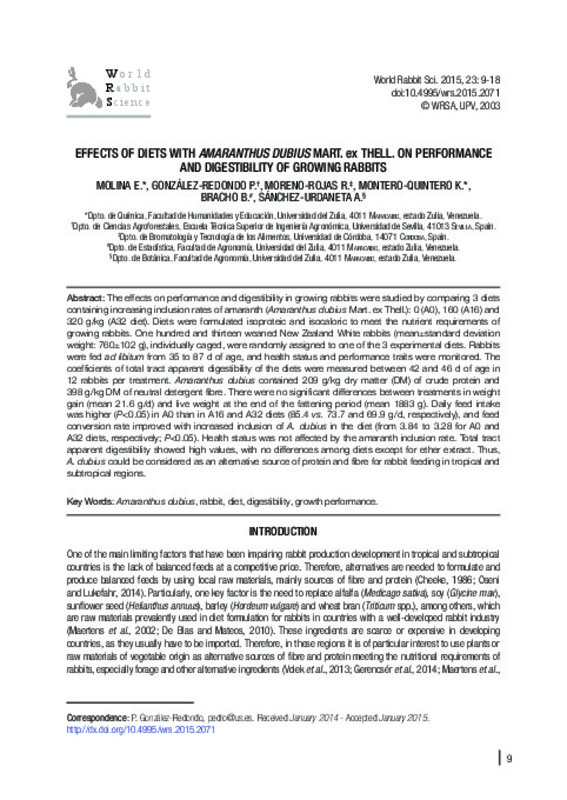JavaScript is disabled for your browser. Some features of this site may not work without it.
Buscar en RiuNet
Listar
Mi cuenta
Estadísticas
Ayuda RiuNet
Admin. UPV
Effects of diets with Amaranthus dubius Mart. ex Thell. on performance and digestibility of growing rabbits
Mostrar el registro sencillo del ítem
Ficheros en el ítem
| dc.contributor.author | Molina, Edgar
|
es_ES |
| dc.contributor.author | González-Redondo, Pedro
|
es_ES |
| dc.contributor.author | Moreno-Rojas, Rafael
|
es_ES |
| dc.contributor.author | Montero-Quintero, Keyla
|
es_ES |
| dc.contributor.author | Bracho, Belkys
|
es_ES |
| dc.contributor.author | Sánchez-Urdaneta, Adriana
|
es_ES |
| dc.date.accessioned | 2015-05-14T07:52:30Z | |
| dc.date.available | 2015-05-14T07:52:30Z | |
| dc.date.issued | 2015-03-26 | |
| dc.identifier.issn | 1257-5011 | |
| dc.identifier.uri | http://hdl.handle.net/10251/50225 | |
| dc.description.abstract | [EN] The effects on performance and digestibility in growing rabbits were studied by comparing 3 diets containing increasing inclusion rates of amaranth (Amaranthus dubius Mart. ex Thell.): 0 (A0), 160 (A16) and 320 g/kg (A32 diet). Diets were formulated isoproteic and isocaloric to meet the nutrient requirements of growing rabbits. One hundred and thirteen weaned New Zealand White rabbits (mean±standard deviation weight: 760±102 g), individually caged, were randomly assigned to one of the 3 experimental diets. Rabbits were fed ad libitum from 35 to 87 d of age, and health status and performance traits were onitored. The coefficients of total tract apparent digestibility of the diets were measured between 42 and 46 d of age in 12 rabbits per treatment. Amaranthus dubius contained 209 g/kg dry matter (DM) of crude protein and 398 g/kg DM of neutral detergent fibre. There were no significant differences between treatments in weight gain (mean 21.6 g/d) and live weight at the end of the fattening period (mean 1883 g). Daily feed intake was higher (P<0.05) in A0 than in A16 and A32 diets (85.4 vs. 73.7 and 69.9 g/d, respectively), and feed conversion rate improved with increased inclusion of A. dubius in the diet (from 3.84 to 3.28 for A0 and A32 diets, respectively; P<0.05). Health status was not affected by the amaranth inclusion rate. Total tract apparent digestibility showed high values, with no differences among diets except for ether extract. Thus, A. dubius could be considered as an alternative source of protein and fibre for rabbit feeding in tropical and subtropical regions. | es_ES |
| dc.description.sponsorship | The authors thank the Consejo de Desarrollo Científico y Humanístico of the Universidad del Zulia (CONDESLUZ) for funding this project, Dr. Rosa Carabaño for his advice on some aspects of the experimental design, and the company Tolsa Group (Madrid, Spain) for donating the sepiolite used in the feed formulation. | |
| dc.language | Inglés | es_ES |
| dc.publisher | Editorial Universitat Politècnica de València | |
| dc.relation.ispartof | World Rabbit Science | |
| dc.rights | Reserva de todos los derechos | es_ES |
| dc.subject | Amaranthus dubius | es_ES |
| dc.subject | Rabbit | es_ES |
| dc.subject | Diet | es_ES |
| dc.subject | Digestibility | es_ES |
| dc.subject | Growth performance | es_ES |
| dc.title | Effects of diets with Amaranthus dubius Mart. ex Thell. on performance and digestibility of growing rabbits | es_ES |
| dc.type | Artículo | es_ES |
| dc.date.updated | 2015-05-14T07:38:45Z | |
| dc.identifier.doi | 10.4995/wrs.2015.2071 | |
| dc.rights.accessRights | Abierto | es_ES |
| dc.description.bibliographicCitation | Molina, E.; González-Redondo, P.; Moreno-Rojas, R.; Montero-Quintero, K.; Bracho, B.; Sánchez-Urdaneta, A. (2015). Effects of diets with Amaranthus dubius Mart. ex Thell. on performance and digestibility of growing rabbits. World Rabbit Science. 23(1):9-18. https://doi.org/10.4995/wrs.2015.2071 | es_ES |
| dc.description.accrualMethod | SWORD | es_ES |
| dc.relation.publisherversion | https://doi.org/10.4995/wrs.2015.2071 | es_ES |
| dc.description.upvformatpinicio | 9 | es_ES |
| dc.description.upvformatpfin | 18 | es_ES |
| dc.type.version | info:eu-repo/semantics/publishedVersion | es_ES |
| dc.description.volume | 23 | |
| dc.description.issue | 1 | |
| dc.identifier.eissn | 1989-8886 | |
| dc.contributor.funder | Consejo de Desarrollo Científico, Humanístico y Tecnológico, Universidad del Zulia | |
| dc.description.references | Acevedo I., García O., Acevedo I., Perdomo C. 2007. Valor nutritivo del bledo (Amaranthus spp) identificado en el municipio Morán, Estado Lara. Agrollanía, Revista de Ciencia y Tecnología, 4: 77-93. | es_ES |
| dc.description.references | AOAC International 2000. Official Methods of Analysis, 17th ed. Association of Official Analytical Chemists, Arlington, VA, USA. | es_ES |
| dc.description.references | AOAC International. 2005. Official Methods of Analysis. 18th ed. Association of Official Analytical Chemists, Maryland, USA. | es_ES |
| dc.description.references | Arellano M.A., Albarracín G., Arce S., Mucciarelli S. 2004. Estudio comparativo de hojas de Beta vulgaris con Amaranthus dubius Mart. ex Thell. Phyton-Int. J. Exp. Bot., 73: 193-197. | es_ES |
| dc.description.references | Bautista E., Barrueta H.D.E. 2000. Bledo (Amaranthus spp.) como ingrediente en dietas para conejos en crecimiento y engorde. Rev. Cient. UNET, 12: 1-17. | es_ES |
| dc.description.references | Cheeke P.R. 1986. Potentials of rabbit production in tropical and subtropical agricultural systems J. Anim. Sci., 63: 1581-1586. | es_ES |








